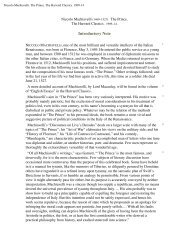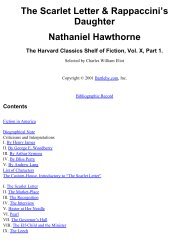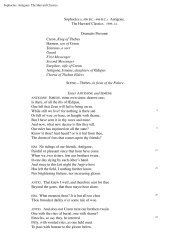Notre Dame de Paris - Bartleby.com
Notre Dame de Paris - Bartleby.com
Notre Dame de Paris - Bartleby.com
Create successful ePaper yourself
Turn your PDF publications into a flip-book with our unique Google optimized e-Paper software.
circumvallation, and immures <strong>Paris</strong> within a chain of massive and lofty towers. For upward of a century<br />
the houses press upon one another, accumulate, and rise in this basin like water in a reservoir. They begin<br />
to burrow <strong>de</strong>eper in the ground, they pile storey upon storey, they climb one upon another, they shoot up<br />
in height like all <strong>com</strong>pressed growth, and each strives to raise its head above its neighbour for a breath of<br />
air. The streets grow ever <strong>de</strong>eper and narrower, every open space fills up and disappears, till, finally, the<br />
houses overleap the wall of Philip Augustus, and spread themselves joyfully over the country like<br />
escaped prisoners, without plan or system, gathering themselves together in knots, cutting slices out of<br />
the surrounding fields for gar<strong>de</strong>ns, taking plenty of elbowroom.<br />
By 1367, the town has ma<strong>de</strong> such inroads on the suburb that a new enclosure has be<strong>com</strong>e necessary,<br />
especially on the right bank, and is accordingly built by Charles V. But a town like <strong>Paris</strong> is in a state of<br />
perpetual growth—it is only such cities that be<strong>com</strong>e capitals. They are the reservoirs into which are<br />
directed all the streams—geographical, political, moral, intellectual—of a country, all the natural<br />
ten<strong>de</strong>ncies of the people; wells of civilization, so to speak—but also outlets—where <strong>com</strong>merce,<br />
manufacture, intelligence, population, all that there is of vital fluid, of life, of soul, in a people, filters<br />
through and collects incessantly, drop by drop, century by century. The wall of Charles V, however,<br />
endures the same fate as that of Philip Augustus. By the beginning of the fifteenth century it, too, is<br />
over-stepped, left behind, the new suburb hurries on, and in the sixteenth century it seems visibly to<br />
rece<strong>de</strong> farther and farther into the <strong>de</strong>pths of the old city, so <strong>de</strong>nse has the new town be<strong>com</strong>e outsi<strong>de</strong> it.<br />
Thus, by the fifteenth century—to go no farther—<strong>Paris</strong> had already consumed the three concentric<br />
circles of wall, which, in the time of Julian the Apostate, were in embryo, so to speak, in the<br />
Grand-Châtelet and the Petit-Châtelet. The mighty city had successively burst its four girdles of wall like<br />
a child grown out of last year’s garments. Un<strong>de</strong>r Louis XI, clusters of ruined towers belonging to the old<br />
fortified walls were still visible, rising out of the sea of houses like hilltops out of an inundation—the<br />
archipelagoes of the old <strong>Paris</strong>, submerged beneath the new.<br />
Since then, unfortunately for us, <strong>Paris</strong> has changed again; but it has broken through one more enclosure,<br />
that of Louis XV, a wretched wall of mud and rubbish, well worthy of the King who built it and of the<br />
poet who sang of it:<br />
“Le mur murant <strong>Paris</strong> rend <strong>Paris</strong> murmurant.” 37<br />
In the fifteenth century <strong>Paris</strong> was still divi<strong>de</strong>d into three towns, perfectly distinct and separate, having<br />
each its peculiar features, specialty, manners, customs, privileges, and history: the City, the University,<br />
the Town. The City, which occupied the island, was the ol<strong>de</strong>st and the smallest of the trio—the mother of<br />
the other two—looking, if we may be allowed the <strong>com</strong>parison, like a little old woman between two tall<br />
and blooming daughters. The University covered the left bank of the Seine from the Tournelle to the<br />
Tour <strong>de</strong> Nesle—points corresponding in the <strong>Paris</strong> of to-day to the Halles-aux-Vins and the Mint, its<br />
circular wall taking in a pretty large portion of that ground on which Julian had built his baths. 38 It also<br />
inclu<strong>de</strong>d the Hill of Sainte-Geneviève. The outermost point of the curving wall was the Papal Gate; that<br />
is to say, just about the site of the Panthéon. The Town, the largest of the three divisions of <strong>Paris</strong>,<br />
occupied the right bank. Its quay, interrupted at several points, stretched along the Seine from the Tour<br />
<strong>de</strong> Billy to the Tour du Bois; that is, from the spot where the Grenier d’Abondance now stands to that<br />
occupied by the Tuileries. These four points at which the Seine cut through the circumference of the<br />
Capital—la Tournelle and the Tour <strong>de</strong> Nesle on the left, the Tour <strong>de</strong> Billy and the Tour <strong>de</strong> Bois on the<br />
right bank—were called par excellence “the four towers of <strong>Paris</strong>.” The Town encroached more <strong>de</strong>eply<br />
into the surrounding country than did the University. The farthest point of its enclosing wall (the one










